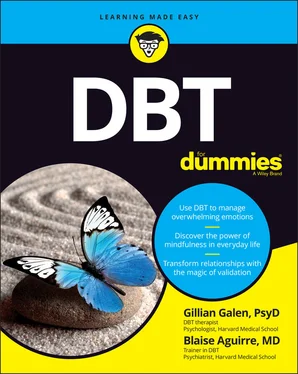 Using DBT to treat specific conditions
Using DBT to treat specific conditions
Entering the world of DBT (dialectical behavior therapy) is entering into a world that focuses on the philosophical process of dialectics, while also attending to the psychological process of behaviorism and change. Imagine entering into a therapy that tells you that everything is composed of opposites, that these opposites are all true, that everything changes except for change itself, and that the way out of suffering is to start by accepting that all of these things are true. This chapter introduces the basics.
Looking at the Main Pillars of DBT
 DBT stands on three big philosophical and scientific pillars. These pillars are specific assumptions that hold the treatment together:
DBT stands on three big philosophical and scientific pillars. These pillars are specific assumptions that hold the treatment together:
All things are interconnected. Everything and everyone is interconnected and interdependent. We are all part of the greater tapestry of all things, a community of beings that supports and sustains us. We are also connected to our family, friends, and community. We need others; others need us.
Change is constant and inevitable. This is not a new idea. The pre-Socratic philosopher Heraclitus said, “The only constant in life is change.” Life is full of suffering, but because change happens, change being the only thing of which you can be certain, your suffering will change as well.
Opposites can be integrated to form a closer approximation of the truth. This is at the core of dialectics. A dialectical synthesis combines the thesis (an idea) and the antithesis (its opposite). In coming up with the synthesis of the two ideas, the process never introduces a new concept not found in either the thesis or the antithesis. Strictly speaking, the synthesis incorporates one concept from the thesis and one from the antithesis.
Check out Chapter 2for more about DBT’s main pillars.
Getting an Overview of DBT’s Treatment Modes and Functions
DBT was originally developed by Dr. Marsha Linehan for the treatment of people who struggled with self-destructive and suicidal behavior, and it subsequently became the gold-standard treatment for the condition known as borderline personality disorder (BPD), which we review comprehensively in Chapter 20. The treatment appeals to many therapists and patients, not only because it is very helpful, but because it integrates four essential elements in a comprehensive treatment by addressing the biological, environmental, spiritual, and behavioral elements of a person’s struggle. It’s also unique in its focus on balancing the need for a person to change while being completely accepted for who they are in the present moment.
As you find out in Chapter 2, DBT delivers the treatment through four modes, and these four modes address the five functions of a comprehensive treatment.
The four modes of therapy
 There are four modes of therapy, which are detailed completely in Chapter 14:
There are four modes of therapy, which are detailed completely in Chapter 14:
Individual therapy: In this mode, a trained therapist works with you to apply newly learned skills to your personal life challenges.
Group skills training: In this mode, together with a group of other patients, you’re taught new behavioral skills, you complete homework assignments, and you role-play new ways of interacting with others.
Phone skills coaching: In this mode, you can call your therapist between sessions to receive guidance on coping with difficult situations as they arise.
Therapist consultation team meetings: In this mode, your individual therapist meets with other therapists who are also providing DBT treatment. These meetings help therapists navigate difficult and complex issues related to providing therapy, and give them new ideas for what to do when they are stuck. Chapter 17goes into more detail on the consultation team.
The five functions of treatment
 As you see in the previous section, DBT is a comprehensive treatment program. In this way, DBT is a collection of treatments, rather than a single treatment method conducted by a single therapist and a single patient. Any program, whichever you choose to do, should address five key functions of treatment (which are fully reviewed in Part 4):
As you see in the previous section, DBT is a comprehensive treatment program. In this way, DBT is a collection of treatments, rather than a single treatment method conducted by a single therapist and a single patient. Any program, whichever you choose to do, should address five key functions of treatment (which are fully reviewed in Part 4):
Increasing your motivation to change: Changing self-destructive and maladaptive behaviors can be very difficult, and it can be easy to become disheartened. Your individual therapist will work with you to make sure you stay on track and reduce any behaviors that are inconsistent with a life worth living. Within individual and group therapy, your therapist will ask you to track your behaviors and use skills coaching in order to achieve this goal.
Enhancing your capabilities: DBT assumes that people who struggle either lack or need to improve several important life skills, including skills that help you regulate emotions, pay attention to the experience of the present moment, effectively navigate interpersonal situations, and finally, be able to tolerate distress.
Generalizing what you’ve learned in therapy to the rest of your life: If the skills you’ve learned in group and individual therapy sessions don’t transfer to your daily life, then it’s going to be difficult to say that the therapy was successful for dealing with your problems.
Structuring your environment in order to reinforce your gains: An important function is to make sure that you don’t slip back into maladaptive or problematic behaviors or, if you do, to make sure that the impact isn’t enduring. Structuring the treatment in a manner that promotes progress toward your goal is a way to do this. Typically, your individual therapist will make sure that all of the elements of effective treatment are in place for you. At times, they may intervene for you if you aren’t yet skilled enough to do so for yourself, with the understanding that such intervention is temporary until you have acquired the skills to manage.
Increasing your therapist’s motivation and competence: Although helping people who come to therapy with multiple problems can be very rewarding for both patient and therapist, the behaviors that people present with can be very taxing for the therapist, and so the therapist needs help to stay in the game of DBT. This is where the DBT consultation team that you read about in the previous section comes in.
Focusing on the DBT Theoretical Framework
The practice of DBT relies on three central theories:
The biosocial theory: Dr. Linehan’s biosocial theory essentially states that people who struggle in regulating their emotions do so because of an enduring interaction between that person’s biological makeup — one that makes them more emotionally sensitive, more emotionally reactive, and slower to return to their emotional baseline — and what she termed the invalidating environment.An invalidating environment is one where a child’s emotional experiences aren’t recognized as valid or tolerated by significant people in the child’s life. When this happens, and a child’s emotional experiences aren’t validated until the child has escalated emotionally and with high intensity, the child effectively learns that they have to escalate to be heard. When they get punished for expressing high emotions, the child might take their difficulties underground and try to regulate by using maladaptive behaviors such as self-injury. This, in turn, leads to even greater emotionality, as the child experiences shame and guilt. Flip to Chapter 2for more about the biosocial theory.
Читать дальше

 Using DBT to treat specific conditions
Using DBT to treat specific conditions DBT stands on three big philosophical and scientific pillars. These pillars are specific assumptions that hold the treatment together:
DBT stands on three big philosophical and scientific pillars. These pillars are specific assumptions that hold the treatment together:










